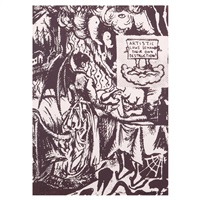Manuel Ocampo
(Filipino, born 1965)
Biography

Manuel Ocampo
A Device Infrequently Recognized As A device, 2000
Sale Date: November 30, 2023
Auction Closed

Manuel Ocampo
The compensatory motif of the libidianl..., 2001
Sale Date: November 6, 2023
Auction Closed

Manuel Ocampo
Discovering the Ground Zero of Criticism, 2006
Sale Date: December 1, 2021
Auction Closed
-otto-dix,-the-artworld,-1972.jpg)
Manuel Ocampo
Manuel Ocampo (b. 1965) Otto Dix, The..., 1998
Sale Date: September 11, 2021
Auction Closed

















![Vorsicht Natur [Beware of Nature], 1993 Vorsicht Natur [Beware of Nature], 1993](http://www.artnet.com/WebServices/images/ll00248lldF0yJFgMVjR3CfDrCWQFHPKcS5XG/manuel-ocampo-vorsicht-natur-[beware-of-nature].jpg)


